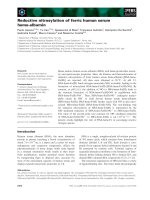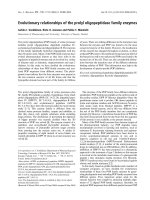Báo cáo khoa học: "Qualitative Modeling of Spatial Prepositions and Motion Expressions" docx
Bạn đang xem bản rút gọn của tài liệu. Xem và tải ngay bản đầy đủ của tài liệu tại đây (60.55 KB, 1 trang )
Tutorial Abstracts of ACL 2012, page 1,
Jeju, Republic of Korea, 8 July 2012.
c
2012 Association for Computational Linguistics
Qualitative Modeling of Spatial Prepositions and Motion Expressions
Inderjeet Mani
Children’s Organization of
Southeast Asia
Thailand
James Pustejovsky
Computer Science Department
Brandeis University
Waltham, MA USA
The ability to understand spatial prepositions and
motion in natural language will enable a variety of
new applications involving systems that can respond
to verbal directions, map travel guides, display in-
cident reports, etc., providing for enhanced infor-
mation extraction, question-answering, information
retrieval, and more principled text to scene render-
ing. Until now, however, the semantics of spatial re-
lations and motion verbs has been highly problem-
atic. This tutorial presents a new approach to the
semantics of spatial descriptions and motion expres-
sions based on linguistically interpreted qualitative
reasoning. Our approach allows for formal inference
from spatial descriptions in natural language, while
leveraging annotation schemes for time, space, and
motion, along with machine learning from annotated
corpora. We introduce a compositional semantics
for motion expressions that integrates spatial primi-
tives drawn from qualitative calculi.
No previous exposure to the semantics of spatial
prepositions or motion verbs is assumed. The tu-
torial will sharpen cross-linguistic intuitions about
the interpretation of spatial prepositions and mo-
tion constructions. The attendees will also learn
about qualitative reasoning schemes for static and
dynamic spatial information, as well as three annota-
tion schemes: TimeML, SpatialML, and ISO-Space,
for time, space, and motion, respectively.
While both cognitive and formal linguistics have
examined the meaning of motion verbs and spatial
prepositions, these earlier approaches do not yield
precise computable representations that are expres-
sive enough for natural languages. However, the
previous literature makes it clear that communica-
tion of motion relies on imprecise and highly ab-
stract geometric descriptions, rather than Euclidean
ones that specify the coordinates and shapes of ev-
ery object. This property makes these expressions
a fit target for the field of qualitative spatial reason-
ing in AI, which has developed a rich set of geomet-
ric primitives for representing time, space (including
distance, orientation, and topological relations), and
motion. The results of such research have yielded a
wide variety of spatial and temporal reasoning logics
and tools. By reviewing these calculi and resources,
this tutorial aims to systematically connect qualita-
tive reasoning to natural language.
Tutorial Schedule:
I. Introduction. i. Overview of geometric idealiza-
tions underlying spatial PPs; ii. Linguistic patterns
of motion verbs across languages; iii. A qualita-
tive model for static spatial descriptions and for path
verbs; iv. Overview of relevant annotation schemes.
II. Calculi for Qualitative Spatial Reasoning. i.
Semantics of spatial PPs mapped to qualitative spa-
tial reasoning; ii. Qualitative calculi for representing
topological and orientation relations; iii. Qualitative
calculi to represent motion.
III. Semantics of Motion Expressions. i. Introduc-
tion to Dynamic Interval Temporal Logic (DITL); ii.
DITL representations for manner-of-motion verbs
and path verbs; iii. Compositional semantics for mo-
tion expressions in DITL, with the spatial primitives
drawn from qualitative calculi.
IV. Applications and Research Topics. i. Route
navigation, mapping travel narratives, QA, scene
rendering from text, and generating event descrip-
tions; ii. Open issues and further research topics.
1









